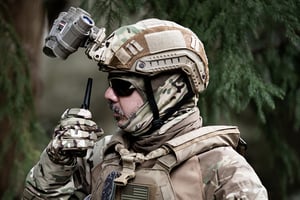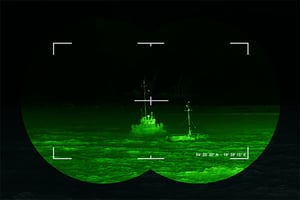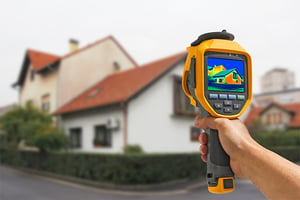 Device name: Night Vision Goggles
Device name: Night Vision Goggles
Also known as: Night-Vision Devices (NVD) or Night Optical/Observation Devices (NOD)
Used by: Military, Law Enforcement, and Civilians
Used for: Surveillance, Navigation, Aviation, Driving, Demining, Star Gazing and more
Battery of choice: 2Ah XR123A (CR123A-size)
What are the two types of night vision goggles?
When you think of night vision then no doubt the image that comes to mind is green, the typical colour displayed by traditional night vision devices. However, a new type of night vision technology is emerging that can digitally capture full color images. Both are typically helmet-worn to allow them to be used comfortably for sustained periods of time.
How do traditional night vision devices work?
In the daytime we see objects because particles of light (called photons) reflect off them and into our eyes. However, at night, the number of photons is drastically reduced and so our vision is impeded.
 Traditional night vision goggles often contain an illuminator that emits infrared light that gets reflected off objects as photons. These photons are then converted into electrons through a specialized material called a photocathode. The signal from the electrons is then boosted thousands of times using a microchannel plate that is powered by one or two CR123A batteries.
Traditional night vision goggles often contain an illuminator that emits infrared light that gets reflected off objects as photons. These photons are then converted into electrons through a specialized material called a photocathode. The signal from the electrons is then boosted thousands of times using a microchannel plate that is powered by one or two CR123A batteries.
A phosphor screen then takes the energy from those electrons and converts it back into visible light, which the user can see when they look through the eyepiece. The image itself is monochrome but a green filter is applied, since the human eye is more sensitive to shades of green in the dark.
How do digital night vision devices work?
On the contrary, digital night vision goggles do not emit infrared light but harness natural light from the moon and stars. An electronic image sensor captures and amplifies this light to display the image on a screen or viewfinder.
What batteries are best for night vision goggles?
 The microchannel plates or sensors used in night vision goggles require relatively low power to function, often sufficing with a single 3V battery. However, as previously stated, goggles are often helmet-worn because they need to operate for extended periods of time. Therefore, long lasting batteries are often the go to power source. Non-rechargeable batteries do not deplete as quickly as rechargeable counterparts; however, batteries from some manufacturers are longer-lasting than those from others. For example, Ultralife has developed a 2Ah CR123A-size battery (called the XR123A) that can run for 40% longer in low-rate applications compared to the competitors’ CR123A. It also has a very small self-discharge to prevent energy loss.
The microchannel plates or sensors used in night vision goggles require relatively low power to function, often sufficing with a single 3V battery. However, as previously stated, goggles are often helmet-worn because they need to operate for extended periods of time. Therefore, long lasting batteries are often the go to power source. Non-rechargeable batteries do not deplete as quickly as rechargeable counterparts; however, batteries from some manufacturers are longer-lasting than those from others. For example, Ultralife has developed a 2Ah CR123A-size battery (called the XR123A) that can run for 40% longer in low-rate applications compared to the competitors’ CR123A. It also has a very small self-discharge to prevent energy loss.
Typically, digital night vision devices use less power than traditional night vision devices because they are sensing light rather than emitting it. This means that they can operate for longer periods of time without needing to have their CR123A batteries replaced.
Would thermal imaging serve my needs better?
 It depends on your application. If you are looking to search over vast distances, then thermal imaging equipment has a longer range. However, if you are planning on using the device for a lengthy period then thermal imaging may not be the best option as it must be handheld and not helmet-worn like night vision goggles. This is because thermal imaging equipment magnifies images and makes them appear closer than they are, which could cause accidents if the user’s field of vision was completely obstructed.
It depends on your application. If you are looking to search over vast distances, then thermal imaging equipment has a longer range. However, if you are planning on using the device for a lengthy period then thermal imaging may not be the best option as it must be handheld and not helmet-worn like night vision goggles. This is because thermal imaging equipment magnifies images and makes them appear closer than they are, which could cause accidents if the user’s field of vision was completely obstructed.
What batteries are best for thermal imaging?
 As thermal imaging devices are handheld, they will typically be used for shorter periods of time than night vision goggles. However, they often need a higher voltage battery because they need to power significantly larger sensors, due to thermal energy having much larger wavelengths than visible light. Therefore, having a long-lasting battery is not quite as crucial but a higher voltage solution is. For this type of application, Ultralife manufacture shrink-wrapped packs in a wide variety of voltages, including 7.2V. These batteries have a long cycle life, so can be recharged around 300 times before needing to be replaced.
As thermal imaging devices are handheld, they will typically be used for shorter periods of time than night vision goggles. However, they often need a higher voltage battery because they need to power significantly larger sensors, due to thermal energy having much larger wavelengths than visible light. Therefore, having a long-lasting battery is not quite as crucial but a higher voltage solution is. For this type of application, Ultralife manufacture shrink-wrapped packs in a wide variety of voltages, including 7.2V. These batteries have a long cycle life, so can be recharged around 300 times before needing to be replaced.
Conclusion
Choosing the best battery for a device depends on the needs of the user. Night vision goggles are often helmet-worn due to long duration usage, so require a long-lasting battery. Thermal imaging equipment is not safe to be helmet-worn, so is often used for less time but requires a higher voltage battery due to its larger sensors.
Speaking to a battery manufacturer like Ultralife can ensure that you get the best battery for your needs.

